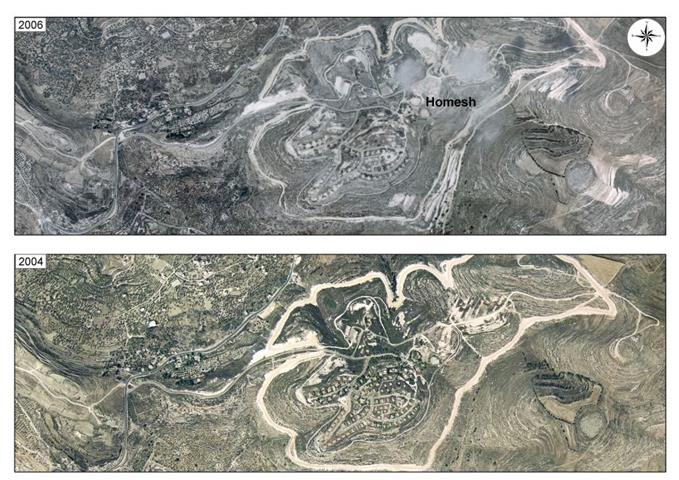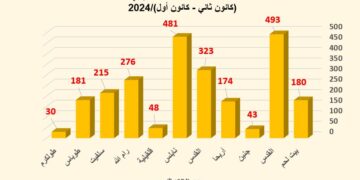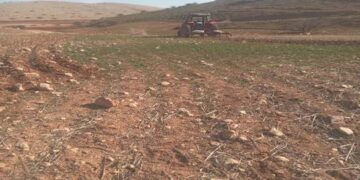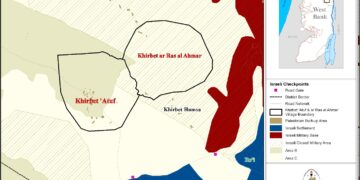In an unprecedented step aiming at obstructing the mission of the newly formed Palestinian Government and the peace process, the Israeli Occupation Army and border police stood watching while hundreds of Israeli settlers marched their way to re-occupy the evacuated 'Homesh' settlement, even though that the Army and police were instructed to stop the settlers. The Israeli settlement “Homesh” was evacuated in the summer of 2005, along with 3 other settlements in the West Bank and 21 settlements in the Gaza Strip. Table 1 details the Israeli settlements dismantled in the West Bank in August 2005.
Table 1: Israeli Settlements evacuated in the Wet Bank in August 2005
|
Settlement Name |
Establishment Date |
Governorate |
Population at the time of evacuation |
Area reserved for settlement before evacuation |
|
Homesh |
1980 |
Nablus |
181 |
1050 |
|
Sanur |
1982 |
Jenin |
112 |
84 |
|
Ganim |
1983 |
Jenin |
147 |
262 |
|
Kadim |
1983 |
Jenin |
142 |
501 |
|
Total |
|
|
582 |
1897 |
Source: ARIJ-GIS Database 2007
The hundreds of marching Israeli settlers towards the location of the evacuated 'Homesh' settlement on March 27, 2007, held placards inscribed with “HOMESH FIRST' referring to the Israeli Right wing determination to re-occupy all the settlements evacuated in August 2005 and to draw the line for the government not to negotiate any agreements with Palestinians that would conclude further Israeli evacuation from more settlements in the West Bank.
Homesh settlement
Homesh Settlement was established in the year 1980, on lands originally belonged to Palestinians from Silat Ad Daher, Burqa and Al Fanduqimiah villages in Nablus Governorate. The three villages lost about 1000 Dunums of the agricultural lands for the construction of this settlement in the beginning of the eighties, see Table 2.
Table 2: Palestinian lands confiscated for the Construction of Homesh Settlement
|
Village's Name |
Location from Homesh Settlement Location |
Area lost for settlement construction (dunum) |
|
Al Fanduqimiah |
North of Homesh Settlement |
74 |
|
Burqa |
South of Homesh Settlement |
814 |
|
Silat Ad Daher |
Northwest of Homesh Settlement |
162 |
|
Total |
|
1050 |
Source: ARIJ-GIS Database 2007
Throughout the years, the Israeli settlements program persisted in the occupied territory and Homesh settlement continued to expand and grow on the expanse of the aforementioned Palestinian villages, Burqa, Al Fanduqimiah and Silat Ad Daher; of which, the village of Burqa, witnessed the greater loss of its lands for settlement expansion particularly between the years 200 and 2004 where the area of the settlements has increased by 100 percent. See Table 3
Table 3: Homesh Settlement Expansion during the period of 1990 and 2004
|
Year |
Area of Homesh Settlement |
|
1990 |
348 Dunum |
|
1996 |
363 Dunum |
|
2000 |
442 Dunum |
|
2002 |
529 Dunum |
|
2004 |
1050 Dunum |
Source: ARIJ-GIS Database 2007
Status of Homesh Settlement before the disengagement plan
Before its evacuation, the settlement occupied a total area of 1050 dunums and accommodated just about 180 Israeli settlers, despite an attractive incentive package to encourage the settlers to come and live in the settlement. The Israeli settlers of Homesh were infamous for their aggressiveness and violent against Palestinians and the settlements’ location among these Palestinian villages has always been a source of fear and despair to Palestinian residents living in the aforementioned villages because settlers often led attacks against residents and lands and caused damages to properties, the last of which was reported on August 11, 2005, a couple of days from the date of evacuation of the Israeli settlements, when a group of Israeli settlers from Homesh settlement aggressed on the lands of Burqa village and set fire to vast areas of the village's agricultural lands which were cultivated with Almond and Vine trees, causing immense losses to Palestinian farmers. In addition, Palestinian residents were often hindered from accessing their lands located close to the settlement particularly during the olive harvest season.
Status of Homesh Settlement following the disengagement plan
Following the evacuation of Homesh settlement, the Israeli Occupation Army destroyed the residential houses where Israeli settlers lived but continued to hold the settlement's location as a military base and from the time the settlement was evacuated until it was re-occupied, Palestinians' movement to the confiscated lands where the settlement existed and even within the vicinity of it remained restricted by the orders of the Israeli Army.
A clear and distinct massage…
The reoccupation of the settlement by the Israeli setters is an explicit and a warning massage to any Israeli government considering further evacuation of any of the West Bank settlements and more than that a message of refusal to the Israeli Government's preliminarily approvalto the Arab Initiative put forward by the king of Saudi Arabia which is to be regenerated during the March 28, 2007, Al Riyad summit, which calls for a complete Israeli withdrawal from the lands Israel occupied during the 1967 war and the Right of Refugees to return to their homeland and the right of self determination.
:::::::::::::::____
¯ Israel said that it is willing to accept the Saudi Initiative, pending further negotiations and discussions that do not include talks of East Jerusalem, Settlements, or Palestinian refugees’ right of return.
Prepared by
The Applied Research Institute – Jerusalem
ARIJ














